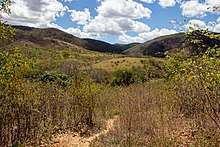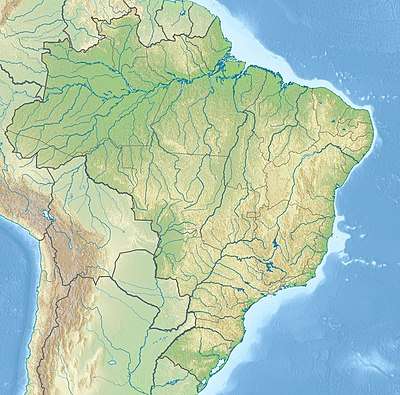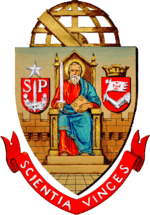BINGO (telescope)
BINGO (Baryon Acoustic Oscillations in Neutral Gas Observations) is a 40 m (130 ft) transit radio telescope currently under construction that will observe redshifted hydrogen line emission (between z = 0.13 and 0.48) by intensity mapping to measure dark energy through baryon acoustic oscillations (BAO) in the radio frequency band.[1][2][3]
 | |
| Location(s) | Brazil |
|---|---|
| Coordinates | 7°02′57″S 38°15′05″W |
| Telescope style | radio telescope |
| Diameter | 40 m |
| Website | www |
 Location of BINGO | |
BINGO will consist of two mirrors: the 40-meter primary mirror reflects radiation from the sky to the secondary mirror that then directs the radiation to a focal plane of 50 horns. The signals will then be focused into a receiver and a spectrometer, after which the data will be analyzed through a data analysis pipeline on a computer.[4]
The radio telescope will be installed in the Serra do Urubu, near the city of Aguiar, Paraíba, in Brazil's northeast.[5] Other locations were evaluated in Uruguay, Rio Grande do Sul, São Paulo and Goiás. The choice of locality in Paraíba was due to the low level of radio frequency interference at the site.[6]
The telescope will operate in the frequency range from 0.96 GHz to 1.26 GHz. [7] With a feedhorn array of 50 receivers, it will map a 15° declination strip as the sky drifts past the field-of-view of the telescope. As of March 2018, the telescope assembly and horn design and fabrication were under way in Brazil.[7]
Consortium
BINGO is funded by the Foundation for Research Support of the State of São Paulo (FAPESP) and MCTIC – FINEP.[8] The Institutions participating in the BINGO Project are: [7][9]
- Brazil: Instituto Nacional de Pesquisas Espaciais (INPE), University of São Paulo (USP), Universidade Federal de Campina Grande (UFCG), Universidade de Brasiília (UnB).
- China: YangZhou University, Shanghai Jiao Tong University.
- France: Université Paris-Sud - Institute d'Astrophysique Spatiale.
- Saudi Arabia.
- Switzerland: ETH Zurich.
- South Africa: Univ. Kwazulu-Natal.
- United Kingdom: Jodrell Bank Centre for Astrophysics at the University of Manchester, University College London.
- Portugal: Instituto de Telecomunicações Aveiro.
- United States of America: Harvard University.
- Uruguay: University of the Republic (Uruguay).
References
- "BINGO - Baryon acoustic oscillations In Neutral Gas Observations". Jodrell Bank Centre for Astrophysics. Retrieved 17 September 2016.
- Battye; et al. (2013). "HI intensity mapping : a single dish approach". Monthly Notices of the Royal Astronomical Society. 434 (2): 1239. arXiv:1209.0343. Bibcode:2013MNRAS.434.1239B. doi:10.1093/mnras/stt1082.
- "Apresentação - Bingo Telescópio". portal.if.usp.br.
- "INPE participa da construção do radiotelescópio BINGO". www.inpe.br.
- "Astrofísica no sertão: radiotelescópio será erguido no interior da Paraíba". revistagalileu.globo.com.
- Peel, M. W.; Wuensche, C. A.; Abdalla, E.; Anton, S.; Barosi, L.; Browne, I. W. A.; Caldas, M.; Dickinson, C.; Fornazier, K. S. F.; Monstein, C.; Strauss, C.; Tancredi, G.; Villela, T. (22 November 2018). "Baryon acoustic oscillations from Integrated Neutral Gas Observations: Radio frequency interference measurements and telescope site selection". Journal of Astronomical Instrumentation: 1940005. arXiv:1811.09464. doi:10.1142/S2251171719400051.
- C. A. Wuesche, "The BINGO telescope: a new instrument exploring the new 21-cm cosmology window". Proceedings of the 4th Algerian Conference in Astronomy and Astrophysics (5 March 2018), arXiv:1803.01644
- "Auxílio à pesquisa 14/07885-0 - Cosmologia (astronomia), Universo primordial - BV FAPESP". bv.fapesp.br.
- "Researches at BINGO Project - Institute of Physics". portal.if.usp.br.
